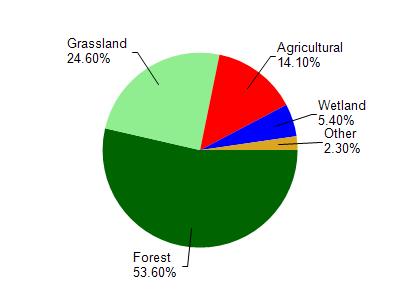Iowa
Yes
No
No
Fish and Aquatic Life
Overview
Spring Valley Creek is a spring fed tributary of Otter Creek. The creek is subject to flooding and bank erosion. The creek supports a Class II trout fishery and experiences problems with nonpoint pollution and as a result of hydrologic modification.
From: Ripp, Coreen, Koperski, Cindy and Folstad, Jason. 2002. The State of the Lower Wisconsin River Basin. PUBL WT-559-2002. Wisconsin Department of Natural Resources, Madison, WI.
Date 2002
Author Cynthia Koperski
Historical Description
Spring Valley Creek - Mouth location T7N R2E Section 10 -10, Surface area = 0.6 acres, Length = 1.6 miles, Gradient = 50.0 feet per mile, Total alkalinity = 235.0 mg/l, Volume of flow = 1.0 cfs.
This stream is spring fed and is a small tributary of Otter Creek (Wisconsin River). It has an intermittent feeder which has no flow in most years. The basin is subject to serious flooding and subsequent heavy bank erosion throughout much of its length. There is a possible source of pollution because of a cheese factory, whose effluent is closely monitored by the Division of Environmental Protection. There is no sport fishery and its forage fish population appears to be limited to creek chubs and johnny darters There are no public lands but it is accessible from one road crossing.
From: Piening, Ronald and Threinen, C.W., 1968. Lake and Stream Classification Project. Surface Water Resources of Iowa County, Wisconsin Department of Natural Resources, Madison, WI.
Date 1968
Author Surface Water Inventory Of Wisconsin
Condition
Wisconsin has over 84,000 miles of streams, 15,000 lakes and milllions of acres of wetlands. Assessing the condition of this vast amount of water is challenging. The state's water monitoring program uses a media-based, cross-program approach to analyze water condition. An updated monitoring strategy (2015-2020) is now available. Compliance with Clean Water Act fishable, swimmable standards are located in the Executive Summary of Water Condition in 2018. See also the 'monitoring and projects' tab.
Reports
Management Goals
Wisconsin's Water Quality Standards provide qualitative and quantitative goals for waters that are protective of Fishable, Swimmable conditions [Learn more]. Waters that do not meet water quality standards are considered impaired and restoration actions are planned and carried out until the water is once again fishable and swimmable
Management goals can include creation or implementation of a Total Maximum Daily Load analysis, a Nine Key Element Plan, or other restoration work, education and outreach and more. If specific recommendations exist for this water, they will be displayed below online.
Monitoring
Monitoring the condition of a river, stream, or lake includes gathering physical, chemical, biological, and habitat data. Comprehensive studies often gather all these parameters in great detail, while lighter assessment events will involve sampling physical, chemical and biological data such as macroinvertebrates. Aquatic macroinvertebrates and fish communities integrate watershed or catchment condition, providing great insight into overall ecosystem health. Chemical and habitat parameters tell researchers more about human induced problems including contaminated runoff, point source dischargers, or habitat issues that foster or limit the potential of aquatic communities to thrive in a given area. Wisconsin's Water Monitoring Strategy was recenty updated.
Grants and Management Projects
Monitoring Projects
| WBIC | Official Waterbody Name | Station ID | Station Name | Earliest Fieldwork Date | Latest Fieldwork Date | View Station | View Data |
|---|
| 1237600 | Spring Valley Creek | 10031754 | Spring Valley Creek upstream of Otter Creek confluence | 1/1/2015 | 1/1/2015 | Map | Data |
| 1237600 | Spring Valley Creek | 10056951 | Spring Valley Cr at Mill Rd | | | Map | Data |
| 1237600 | Spring Valley Creek | 10031755 | Spring Valley Creek upstream of confluence with Hunter Hollow | 1/1/2015 | 1/1/2015 | Map | Data |
|

Watershed Characteristics
Spring Valley Creek is located in the Otter and Morrey Creeks watershed which is 198.69 mi². Land use in the watershed is primarily forest (53.60%), grassland (24.60%) and a mix of agricultural (14.10%) and other uses (7.70%). This watershed has 437.57 stream miles, 351.55 lake acres and 5,785.74 wetland acres.
Nonpoint Source Characteristics
This watershed is ranked Not Ranked for runoff impacts on streams, Low for runoff impacts on lakes and High for runoff impacts on groundwater and therefore has an overall rank of High. This value can be used in ranking the watershed or individual waterbodies for grant funding under state and county programs.However, all waters are affected by diffuse pollutant sources regardless of initial water quality. Applications for specific runoff projects under state or county grant programs may be pursued. For more information, go to surface water program grants.